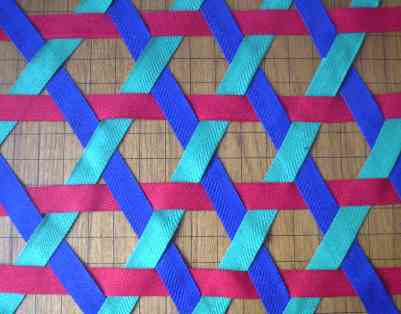
Triaxial Weaving
Triaxial weaving
Triaxial weaving produces material which is structurally superior to most
sorts of rectangular weaving. Since the structural elements run in three
directions, the resulting fabric is much more resistant to shearing forces.
Here are the two most common types of triaxial weaving:
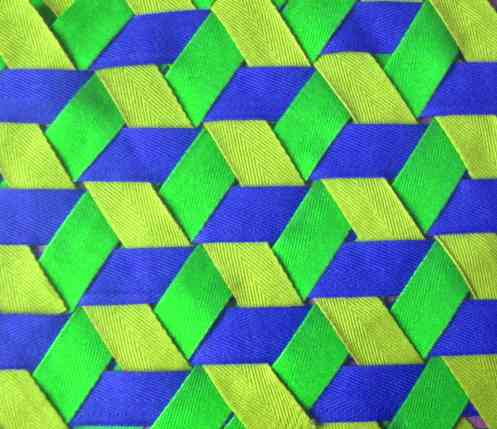
Dense triaxial weave
This fabric has three layers of material at any point - and
is thus stronger than a rectangular woven fabric made using
the same elements.
Unfortunately, this fabric is relatively difficult to
manufacture.
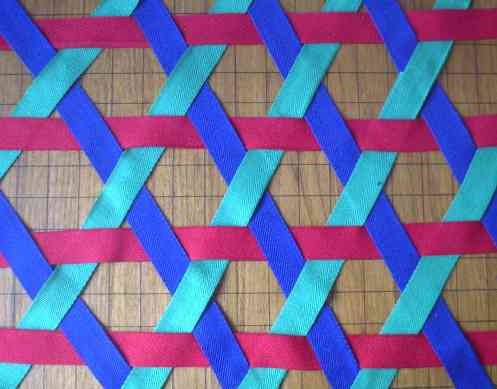
Sparse triaxial weave
This fabric is sparse. It
typically has about a third of
the structural elements of the first fabric.
One of the feature of this fabric that it has holes in it.
While this makes it unsuitable for some
applications, it does help with applications which
require ventilation - such as ladies stockings, linen
baskets or underwear.
Alternatively, it is appropriate where a light
material is required - that is still very strong.
As far as I know, this sort of weave is the lightest simple
weave known to man.
It also has the advantage of being pretty easy to
manufacture.
More diagrams
These diagrams show what sparse triaxial weaving looks like
on a larger scale:

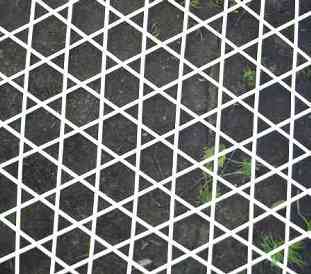
Statistics
Some calculations relating to triaxial weaving:
| \ |
Density |
| Rectangular |
2.00 |
| Triaxial (sparse) |
1.00 |
| Triaxial (dense) |
3.00 |
| Diamond |
2.00 |
Ribbon-based model
| \ |
Density |
Sphere seive: cost |
Disc seive: cost |
| Rectangular |
2.00 |
2.00 |
2.82 |
| Triaxial (sparse) |
1.73 |
3.00 |
3.46 |
| Triaxial (dense) |
5.19 |
3.00 |
3.46 |
| Diamond |
2.31 |
2.00 |
4.00 |
| Hexagonal |
1.15 |
1.00 |
1.15 |
Wire-based model
The figures are derived from models based on "ribbon" or "wire".
The "ribbon" is considered to be a material which is very
wide in one dimension, while very narrow in another. The
"wire" is considered to be a very thin, but highly
inflexible material. In practice, most real materials will
fall somewhere between these extremes.
Sparse triaxial weaving using ribbons typically uses 50% of
the quantity of material to cover the same area as
rectangular rectangular weaving - while dense triaxial
weaving uses 150% of material to cover the same area.
If the material is ribbon-like the difference between
rectangular weaving and triaxial weaving is dramatic.
However - if the material is wire-like, there's not very
much in it.
The "seive" costs were intended to determine whether it
makes financial sense to build seives out of triaxial woven
fabrics. Two sorts of seive were considered - based on
whether the objects being seived were spheres or discs.
The figure represents the material cost (per unit area) to
prevent the passage of objects with diameter 1 unit.
The "Hexagonal" entry is not really a weave. It is
impossible to construct it using continuous strands. The
figures are given to allow comparisons with the ideal
arrangement.
In summary: even if you ignore the problems caused by the
variable-size pores; triaxial weaving probably makes little
sense in this application.
Applications
What applications are suitable for using triaxial techniques?
The main selling points of triaxial weaving are:
- Light weight;
- Low cost;
- Shear-resistance.
These are desirable traits for many applictations.
In particular, light shades, baskets and underwear seem
particularly attractive applications for this sort of
weaving.
Construction
Sparse triaxial weaving uses three sets of parallel fibres, known as the
warp, the whug and the weft.
The whug is not present in conventional rectangular weaving. During
construction it acts very much like a second warp.
The warp can be laid down in simple parallel lines. The whug is then
laid down on top of it - again in simple parallel lines.
Finally the weft is woven in and out of both layers - to create the final
fabric.
Patent
For many years triaxial fabrics were the subject of a patent:
See [here] for details.
This patent covers the "dense" form of triaxial weaving. It has now expired.
Medium triaxial weave
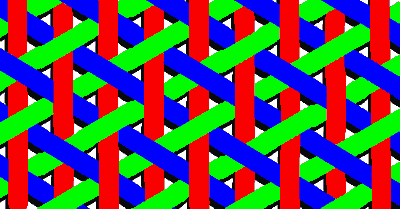
Medium triaxial weave
Here's a medium-density triaxial weaving pattern.
It is similar to the dense weave - but apparently not so symmetrical.
As with the other triaxial weaves, it should offer good shear resistance.
References
Tim Tyler |
Contact |
http://hexdome.com/
|